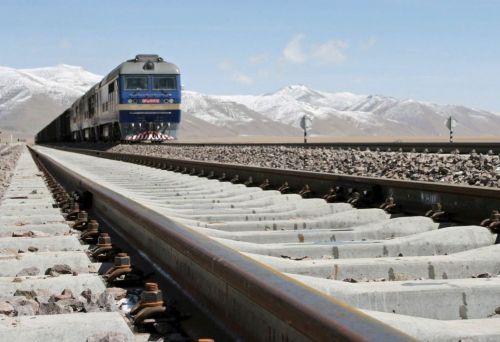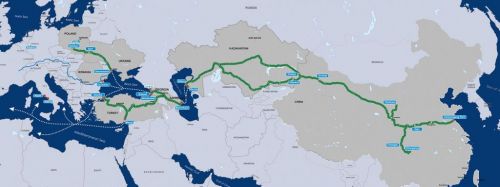The longer the war in Ukraine lasts, the clearer becomes the prospects for the development of the so-called Middle Corridor (or the Trans-Caspian route), the part of the New Silk Road that passes through countries in Central Asia, the Caucasus, the Caspian Sea, and the Black Sea. Russia's war against Ukraine and the sanctions imposed on Russia have become catalysts for the development of this corridor, which previously played a minor role in the transportation of goods on transit from China to Europe (3-5% of the total transport volume). Instead, it can become an alternative to the transportation of goods by sea through the Suez Canal and by rail through Russia and Belarus. Countries on both sides of the Caspian Sea understand this, and they are trying to grab their share of the cargo transit "pie" that has emerged due to the redistribution of global logistics.
Kazakhstan
This Central Asian country, which accounts for a significant share of China-Europe cargo transit volumes, is making serious efforts to develop the corridor. It is proposing transporting both goods from the People's Republic of China and the raw materials that Kazakhstan itself exports (crude oil). Nur-Sultan decided to take the final step to diversify the export routes for its crude oil after the Russians blocked the transshipment of Kazakh crude oil through the terminal in Novorossiysk, albeit for a short time.
Regarding the development of cargo transit between China and Europe, Kazakhstan is implementing a systematic policy that consists of creating the most attractive conditions for shippers.
The second phase of the Dostyk TransTerminal cargo transshipment terminal was opened at the Dostyk station, which is the main railway "gateway" between Kazakhstan and China, in May 2022. PTC Holding invested USD 19 million in this project. The first phase of this terminal was launched into operation last year.
To encourage shippers to use the route, the country has announced a 65% discount on the transportation of rail freight from the Dostyk station on transit through its territory to the port of Aktau on the Caspian Sea. Yermek Sadykbekov, an advisor at the embassy of Kazakhstan, announced this at the Fracht intermodal transport forum in Poland last month. He also announced that the volume of cargo transportation through the Middle Corridor has increased by 75% this year, compared with 2021. In addition, the volume of container transportation has increased by 52%.
Meanwhile, Kazakhstan’s Caspian ports are still not operating at even a quarter of their capacity. Currently, cargo transportation on feeder routes between the ports of Aktau and Baku (Azerbaijan), which is located on the other side of the Caspian Sea, is performed by Azerbaijan Caspian Shipping Company (ASCO) and Kazakhstan’s national carrier Kazmortransflot. The latter uses four dry cargo vessels to transport containers on the route, but it plans to increase its transport volumes: it plans to increase the number of cargo vessels to six by the end of the year and 10 later. "In addition, we plan to build the port of Aktau into a container hub in connection with the fact that our container flow is increasing," said Kasym Tlepov, the acting head of the transport committee at Kazakhstan’s Ministry of Industry and Infrastructure Development. According to him, three dry cargo terminals and a ferry complex have already been built in this port.
In addition, the first cargo train passing through the territories of Turkmenistan and Iran departed from the Kazakh city of Pavlodar for Turkey in June. However, the fact that Iran is under U.S. sanctions limits the possibilities of cargo transit through its territory due to the refusal of insurance brokers to cover possible risks. Therefore, this route is currently considered more like an additional option.
The main routes pass through the port of Aktau to Baku and then through the Azerbaijani and Georgian railways to the ports of Batumi and Poti (the first option) or the Baku-Tbilisi-Kars railway to the Turkish ports of Istanbul and Mersin (the second option).
In the near future, Kazakhstan's leadership plans to continue developing railway freight transit by creating alternative routes. For example, the country's president Kassym-Jomart Tokayev recently ordered the construction of several railway tracks from the country’s borders with China and Uzbekistan into the interior of the country, including a new railway border crossing on the border with the People's Republic of China. A plan for the construction of a branch railway line bypassing the city of Almaty to improve the throughput capacity of the Kazakh railways is also part of this.
Azerbaijan
Baku also understands the importance of developing the Trans-Caspian route, the potential of which it plans to take full advantage. ADY Container, a subsidiary of Azerbaijan Railways, announced an increase in the intensity of transportation on the route in the spring. In particular, it announced plans to launch two new rail and sea services to the Romanian port of Constanta: the first from the Kazakh port of Aktau and the second from the Turkmen port of Turkmenbashi. In addition, the company added another ship to its route in the Black Sea in June. Currently, two container ships belonging to ADY Container operate on the route between the Georgian port of Batumi and the Romanian port of Constanta. The company operates six services per month.
The route through Romania has become quite a popular option, although the transit time is relatively long (40 days). One of the reasons for this is traffic congestion in the Romanian port due to poor railway infrastructure, as well as the need to transship Ukrainian agricultural products in this port.
In addition, goods can be transported through Azerbaijan on a land route that passes through Turkey. The Baku-Tbilisi-Kars railway has been facilitating cargo transportation between Asia and Europe for several years, and it is most useful for transporting goods to destinations in southern Europe. However, according to Azerbaijani transport expert Rauf Agamirzayev, the capacity of this route on the Turkish side is insufficient. "The daily carrying capacity on the section that receives cargo from Baku-Tbilisi-Kars in Turkey is 3,500 tons. It is necessary to increase it because it is insufficient for the cargo flows heading to the Middle Corridor," Agamirzayev is quoted as saying in the Report publication.
In the Azerbaijani section, the 40 new locomotives that ADY received from the Alstom company, the modernization of the Azerbaijani railways, and the gradual transition of the railways to the 25 kV alternating-current traction system are facilitating the increase of the section’s capacity.
Georgia
This Caucasus country is actively promoting the idea of using its seaports as part of a chain connecting the Caspian Sea and the Black Sea, in addition to the railway (particularly the Baku-Tbilisi-Kars line). This was Georgian Ambassador to Poland Zurab Beridze’s main message at the Fracht intermodal transport forum in Warsaw.
Tbilisi is currently focusing on broadening the capabilities of automobile roads. One of the largest projects that will become part of the East-West corridor in the country is the construction of the E60 expressway (the Ricotti highway). There will be 47 tunnels and 80 bridges on this route. Half of the tunnels have already been drilled and some of them are already in normal use. According to the Georgian authorities, progress is also being made on the construction of the bridges: the installation of the longest steel bridge is currently underway. "Special sections of the new Ricotti bypass road will open this year, and the construction of the new, main Ricotti road will be completed in 2023," Minister of Regional Development and Infrastructure Iraklii Karseladze said.
As for the Georgian railway, it is attracting increased dry cargo to the Middle Corridor. The volume of cargo transported by international rail was 10.2 million tons in 2021, which is 11.3% more than the 9.2 million tons that was transported in 2020. The number of containers transported on the Baku-Tbilisi-Kars road was 20,492 TEU in 2021, which is 95.7% more than the number in 2020. The number of containers sent from and to China through the Middle Corridor was 10,094 TEU in 2021, which is 221.6% more than the number in 2020.
Turkey
Ankara also sees itself as an even more active participant in the Middle Corridor. According to Turkey’s Minister of Transport Adil Karaismailoglu, as partners, Turkey, Bulgaria, Serbia, and Hungary are striving to become "regional and global leaders in logistics," in which the Silk Road’s Middle Corridor will play a key role. For this purpose, a working group was set up to consider the issue of railway infrastructure at a recent meeting of the transport ministers of these countries.
Turkey plans to complete the construction of the Kapikule – Halkali high-speed railway line this year. It aims to improve the links between Istanbul and the Turkish-Bulgarian border and thus develop rail links between the European Union and Turkey. It is part of the historical Istanbul Sirkeci – Svilengrad line of the 1870s, which is no longer suitable for handling modern traffic volumes.
The EU is financing the section from Kapikule near the Bulgarian border to Cerkezkoy with a grant of EUR 25 million. The Cerkezkoy – Halkali section is financed by the Turkish government and it costs EUR 278 million.
The railway branch will facilitate the movement of trains at a speed of 200 km/h. Unlike most high-speed projects, which are limited to passenger transportation, this railway line is being created for freight rail traffic as well. According to various sources, cargo transportation on the line will increase from 1.53 million tons to 9.6 million tons per year.



